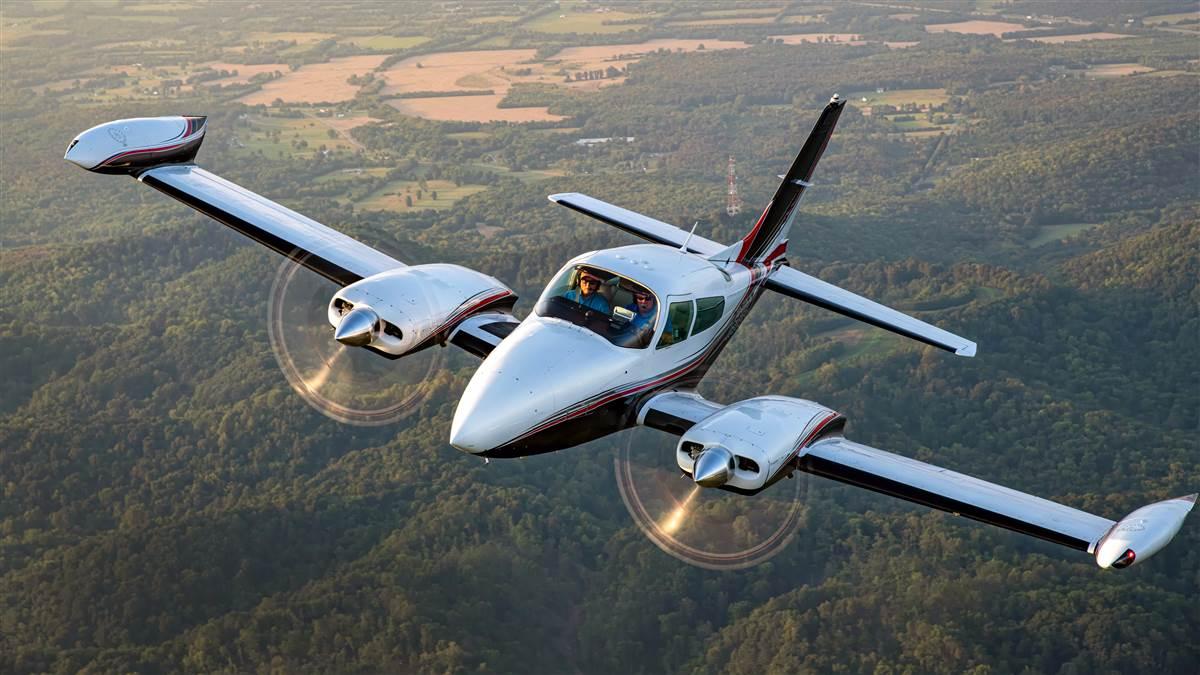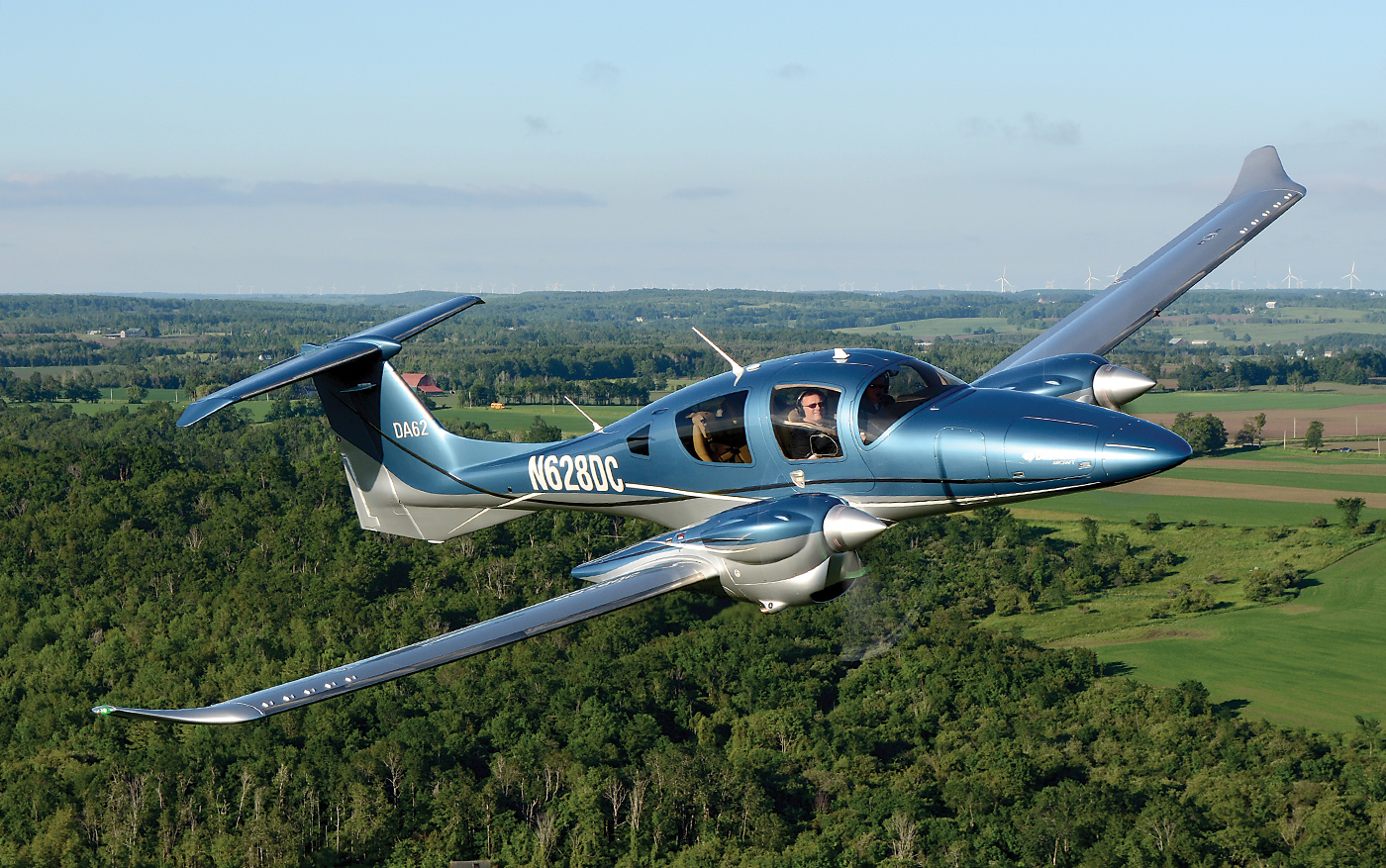Twin Piston Aircraft - Intangibles such as peace of mind are often decision-makers for owners and operators. Many prefer the redundancy of a twin-engine aircraft when their typical missions take them over mountains or large bodies of water. Some twin-engine models, like the BEECHCRAFT® BARON® aircraft, include added engineering that keeps all systems—even cabin comforts—running off one engine.
Piper Seminole—PA-44: The Seminole was born at a time when several companies were offering new, four-seat, twin trainers. In the late 70s, Beech introduced the Duchess, Grumman American premiered the Cougar and Piper unveiled the Seminole.
Twin Piston Aircraft

Only the Seminole survived. With its tall, T-tail and seemingly indestructible Lycoming O-360 engines, the PA-44 has remained in production, admittedly intermittently, for 36 years. The airplane has become a favorite with institutional flight schools but also occasionally sells to individuals and business flyers who enjoy the redundancy of two engines and can live with a 150-160 knot cruise.
Peace Of Mind
Plane and Pilot builds on more than 50 years of serving pilots and owners of aircraft with the goal of empowering our readers to improve their knowledge and enthusiasm for aviation. Plane and Pilot expands upon the vast base of knowledge and experience from aviation’s most reputable influencers to inspire, educate, entertain and inform.
The King Air series offers flexible, reconfigurable interiors, making them equally adept at accommodating passengers, cargo, air ambulance or other missions. It’s no surprise organizations choose Beechcraft to transport their important personnel and cargo – no matter where they fly.
At the time, there was talk of a pilot shortage, and the three twin trainers were designed specifically to meet that need and provide an economical flying classroom to teach the next generation of airline pilots.

As in the 1980s, the Vulcanair P68 flies with perhaps Lycoming’s most durable engines on the wings, the ubiquitous, 200 hp IO-360-A1B6, rated for 2000 hours TBO. The retractable version is quite a bit quicker than the original fixed-gear model, 168 knots at 8000 feet. Service ceiling on both engines is listed at 20,000 feet; shut down one engine, and that’s reduced to 5000 feet.
Beechcraft King Air
Today, the Partenavia has been revived as the Vulcanair. Again, there are a myriad of models available, all based on the original Partenavias. Vulcanair has added an unpressurized turboprop model and a retractable to the mix, the P68Vr. Like the Tecnam P2006T, the Vulcanair retracts its wheels into a short pylon beneath the cabin.
Vulcanair P68Vr: Another entry from Italy, the Vulcanair, is a follow-on to the Partenavia P-68 series of light twins from the 1980s. In those days, the Naples, Italy, company offered three basic models, all six-seat twins, a normally-aspirated and turbocharged version in standard configuration and a clear-nose airplane (named the Observer) intended for law enforcement, pipeline patrol, wildlife management and other tasks demanding a good view of the ground. (The American distributor was Mira Slovak in Santa Paula, Calif., my neck of the sky, so guess who ferried four of the type from Naples, Italy, to Santa Paula.)
Multi-engine, piston aircraft were very much in style back in the 1970s and 1980s. Those were the days of $1.50/gallon avgas. At the time Piper, Cessna and Beech collectively had thirteen twin-engine models in production in the late ’70s. Today, Piper builds two, Beech offers one and Cessna has abandoned all twin engine, piston construction.
Diamond DA-42-VI Twin Star: Of the remaining international twins, Diamond’s entry couldn’t be any more individual. The Diamond Twin Star looks like something Luke Skywalker might pilot, it flies behind a pair of FADEC-controlled Austro diesel engines, sports dramatically upturned winglets on the tips and generally manifests a modern-as-tomorrow demeanor.

Beechcraft Denali
If your mission profile still has you deciding between a single-engine and twin-engine aircraft, maintenance costs could be the deciding factor. A common misconception is a twin-engine aircraft costs twice as much to maintain and operate, because it has two engines. While it’s true keeping up with inspections, overhauls and unscheduled repairs will cost you more on a twin-engine than a single-engine, overall it’s considerably less than double the price.
This isn’t a knock against twins, . There’s no question that pilots who operate over water or above mountains can benefit from the second engine. There’s also no question that a multi-engine aircraft, properly flown following an engine failure, can save your life.
With both engines turning, the 2006T delivers 1,140 fpm climb. Shutting down power on one side reduces that to 212 fpm, and single engine service ceiling is 7000 feet. Cruise on both Rotax 912Ss is 140 knots, so the airplane’s 54 gallons are good for about 4.5 hours plus reserve.
As you might expect, the modern Seneca V does everything better. Horsepower is up to 220, the avionics suite is the Garmin 1000 and the level of refinement is excellent. Cruise in the flight levels is better than 180 knots, and interior room is better than a Baron, more reminiscent of a Navajo’s cabin than a light twin’s. At 48 inches across, the Seneca V’s elbow room is equal or superior to that of any other piston twin.
Let Your Needs Narrow Your Choices
Beech G58 Baron: Teledyne Beechcraft’s lordly Baron is quite literally the top of the multi-engine class. It’s not only the most expensive production, piston twin on the market; it’s also the best performing and, arguably, the most agile handling of the group. Over the years, I’ve had the pleasure of delivering a half-dozen of the type across one or another ocean, and the trips have always been a pleasure.

The BEECHCRAFT family is growing once more as the Beechcraft DENALI single-engine turboprop joins the legendary line-up. This high-performance aircraft exemplifies the luxury, durability, and class that is found in our Beechcraft products. Designed with more range, more efficiency, less maintenance, lower operating costs, advanced flight deck, smarter cabin space and a superior service network, the Beechcraft Denali turboprop will rise above the competition.
Today, the company’s Austro AE-300 turbo-diesels power the DA-42 with 168 hp per side and a 1500 hour TBO. In combination with a 44 foot span, high aspect ratio wing, this provides the standard DA-42-VI with a sea level climb of 1800 fpm and a max cruise of 197 knots. Fuel burn is only 10.4 gph total, so the 74 gallon long range tanks allow the Twin Star to cover 795 nm between fuel stops.
Additionally, even pilots with the means to buy and operate a twin are beginning to challenge the safety records of multi-engine piston airplanes over singles. The sad clich in the industry is that the only real use for the second engine if the other one quits is to transport you directly to the site of your accident.
Tecnam P2006T: About eight years ago, Tecnam, the well-established, Italian LSA manufacturer, hit upon the novel idea of mounting a pair of 100hp Rotax engines on the wings of a miniature Aero Commander look-alike, and offering what has to be the world’s least expensive, multi-engine trainer.
The Baron G58 piston is complete with comforts you’d expect from an inviting retreat. The 137 cu ft cabin features four seats in a club configuration, complete with lumbar support and headrests. The cabin has many amenities like leather seats, powered headset jacks, dual USB ports, reading lights and climate-controlled individual air vents. The cabin is configurable to fit your needs for legroom, large baggage or cargo.

There were once three Barons, but today, the 2015 G58 represents the most polished and sophisticated Baron ever offered. Beech products have always been blessed with a build-quality and control harmony that few other models can match, and the newest Baron exemplifies the best.
With an inevitable pair of 300 hp, Continental IO-550s on the wings, the Baron climbs at a maximum 1,730 fpm. Go to the whip at 7500-8500 feet and the G58 will manage 200 knots on about 36 gph. That provides 4.5 hours endurance for a range approaching 1,000 nm.
One slight problem is that the G58 has a fairly heavy empty weight. The result is a full fuel payload of only 330 pounds. That’s roughly two folks in the six, ultra-comfortable seats. If you need to fly two hours at max cruise, you can leave 65 gallons in the truck and still have payload for four folks plus baggage and a range of a least 600 nm.
Length - 29 ft 10 in (9.1 m) Height - 9 ft 9 in (3.0 m)
For a twin, the Seminole is a relative lightweight at 3,800 pounds gross weight, and its counter-rotating propellers help tame the dreaded Vmc problem. Single-engine climb at gross is an relatively anemic 212 fpm, but in fairness, that’s not much worse than the other twins in the class Still, this trainer is marginal in Albuquerque during summer.

The BARON G58 piston is the perfect balance of horsepower combined with peace-of-mind, twin-engine redundancy and security. With seating for six, large cargo doors and two baggage compartments, the Baron G58 piston offers great flexibility for both business and pleasure.
Among the many decisions you will make when choosing an airplane is whether to purchase a single-engine or a twin-engine model. Thousands of business owners and recreational pilots begin their venture into aviation with a single-engine piston airplane, while others find a twin-engine better fulfills their needs.
I flew the first, P2006T delivered to the U.S. at Oshkosh in 2009, and any tendency to laugh at the concept was immediately dispelled. Designer Luigi Pascale (designer of the P68 series Partenavia twins) elected to fold the wheels into pylons on the bottom center of the fuselage, mounted fully featherable props on the Rotax 912S, geared, liquid-cooled engines and wound up with a viable, four-seat twin with remarkably inexpensive operating costs.
The pair of 200 hp, Continental TSIO-360 engines were turbocharged, so I never feared high-altitude airports (the airplane accepted several operations at Leadville, Colorado, elevation 9,927 feet MSL, without complaint), and the 123-gallon fuel capacity allowed easy four-hour hops plus reserve, worth 700 nm between pit stops. Long range power settings could stretch that to well over 800 nm.
There are several reasons for the cutbacks, but the primary one is simply economics. Twins no longer make sense when avgas can cost $6/gallon and maintenance at any good shop will set you back $100/hr. Never mind how much is too much.
Flying a single-engine or a twin-engine aircraft requires the same base instruction and licenses, but if you’re planning to fly a multi-engine aircraft, the Federal Aviation Administration requires more training, because with two engines, there’s more to manage and monitor in the cockpit.
Today’s Seneca V is more of a luxurious traveling machine. I spent three years and 700 hours with a Seneca II company airplane, and it performed every mission I could think of better than I had any right to expect. Most of the time, my flights were medium to long distance business travel, in one case an editorial, round robin from Los Angeles to Key West to Calgary, Canada, and back to Los Angeles.
The Baron G58 aircraft is powered by the latest technology in integrated cockpits, the GARMIN G1000 NXi avionics. Managing the flight deck has never been easier with the new GMC 707 autopilot control panel. The new Garmin GI 275 electronic standby lets you keep the classic look of your standby instruments while upgrading to a modern, sleek glass touchscreen display.
best twin engine piston aircraft, pressurized twin engine piston airplanes, twin engine aircraft for sale, new twin engine aircraft, new twin engine piston aircraft, controller aircraft piston twins, best twin piston engine planes, small twin engine aircraft